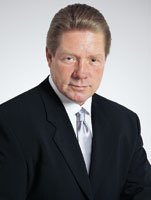Q & A with St. John CEO H.W. Mullins
What interested you in joining St. John?
The thing that is appealing to me about this company is the fact that it is a very solid, healthy company with a very powerful brand. Often, when you have the opportunity to come in as CEO of a company, it’s because there are problems. We don’t have that situation. It’s a company that has the financial resources to pursue opportunities. It’s a private company, so we don’t have to answer to Wall Street every quarter or to a bunch of shareholders as to why we are making the investments we are making. And it’s a company that has a powerful, powerful brand in apparel but has never really translated that apparel strength into other categories such as shoes, accessories, bags, jewelry and those sorts of things. I saw a very strong, healthy company with the resources and the opportunity to be even stronger and healthier.
What are some of your plans for the company?
To continue to grow the business that we have today in the knit collection and the sport collection. But, in addition to that, to do two things. First is to make us a more diverse company, that isn’t a pure apparel company. We have such a powerful, loyal customer base that is so loyal to St. John, that has really grown dramatically over the last few years, and those ladies have needs beyond apparel. They buy St. John’s wonderful apparel and they buy someone else’s shoes, someone else’s jewelry, someone else’s handbags and someone else’s cosmetics. My vision is to find a way to develop products in those categories that can have the same appeal to that lady that we already have a relationship with in apparel.
We do [have a St. John shoe business] but the business is tiny and it’s primarily in our boutiques. We do some business with Nordstrom and we do a little bit of business with Neiman Marcus. But when you look at our accessories business besides apparel, it’s less than 10 percent of our total. If you look at Neiman’s business or Saks’ business or Nordstrom’s business, their accessories business is at least as big as their ready-to-wear business. So we know there’s at least as much opportunity out there. And if you look at people like Prada or Gucci, for example, they do far more accessory business than they do ready-to-wear business. If we can find a way to tap into that success, it really can grow our business and eventually that can potentially be a very profitable business.
Do you think St. John accessories could eventually be 50 percent of the business?
I don’t think it’s going to be 50 percent of the business in the next couple of years. In this kind of business, once you make up your mind to go after it, it takes a year or so to put the ingredients in place to just get started. My goal would be to get it to maybe a quarter of the business relatively quickly and then the ultimate goal—the ideal—is to have it as big as the apparel. And good thing for us, the apparel [business] continues to grow.
Shoes and handbags are a logical step, but a full cosmetics line seems to be an unusual extension for a designer line.
We have some fragrance now and we have things like candles and some lotions and that kind of thing. The lady who loves St. John clothes really loves them for a couple of reasons: they fit very well, they are flattering and durable; they also love the color. So color from a standpoint of cosmetics is also a natural segue for [the company]. And when you look at the amount of jewelry that women buy these days—and there are huge designers out there doing jewelry business—-I guarantee you the St. John’s apparel woman is buying their jewelry.
Have you always been on the retail side of the business?
I have. I started my career years ago with Federated department stores and then spent the last 10 years at Neiman Marcus, the last year as chairman and CEO. How are you enjoying being on the other side of the business?
The good news is there’s a lot to learn, but the experience that I had in retail is a value on this side as well. There are a lot of wholesalers out there that started out in retail. There are so many interesting things to learn about production and about marketing and about design that you really don’t get exposed to on the retail side. The other good thing is the Gray family, which has been the cornerstone of this business, has been so helpful and they are great tutors and teachers and mentors. Mr. Gray is still here and will be here, it’s not like I have to come in here and make radical changes, it’s not like I have to run everything from day one. I really get the luxury of transitioning into the responsibility.
Living in Orange County is a pretty nice perk to go along with this [as well]. I was living in Dallas. Dallas is a great city but it doesn’t have the physical beauty that Orange County has and I don’t know anyplace that does. It’s very nice to live here.























